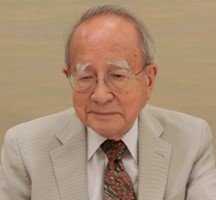Seiya Uyeda (1929 - 2023)

On January 19, 2023, Seiya Uyeda, Professor Emeritus of the University of Tokyo, passed away at the age of 93 in Tokyo, Japan.
Professor Seiya Uyeda graduated from the University of Tokyo in 1952 and received the degree of Doctor of Science (University of Tokyo) in 1958. He became a Research Associate at the Earthquake Research Institute, the University of Tokyo in 1955. In 1964, he was appointed Associate Professor at the Earthquake Research Institute and was promoted to Professor in 1969. After his retirement from the University of Tokyo, he continued his research and teaching as a Professor at the Tokai University from 1990 to 2008, and as the Group Director of the RIKEN (Institute for Physical and Chemical Research) International Frontier Research Program on Earthquakes from 1996 to 2002. For these long years of distinguished service, he was elected a member of the Japan Academy in 1996.
In the midst of the 20th-century Earth science-revolution of seafloor spreading theory and plate tectonics, he conducted diverse research in various fields of solid Earth science, including geo-electromagnetics, geothermics, and tectonics, and greatly contributed to the creation of a "new view of the Earth". Even after the establishment of plate tectonics, he continued to pursue a newer view of the Earth, promoting research based on novel ideas one after another and leading the Earth science community in the world.
His early research was mainly on rock magnetism. One of the most important of these studies was the discovery of thermoremanent magnetization (TRM) directed opposite to the magnetic field and that this phenomenon, self-reversal TRM, is a peculiar property of certain magnetic minerals. This result became his dissertation, and he was awarded the Tanakadate Prize of the Society of Terrestrial Magnetism and Electricity of Japan (1953).
In the late 1950s, he made the first measurements of terrestrial heat flow in Japan, and then energetically continued to measure heat flow in the seas surrounding the Japanese Islands and in the eastern Pacific. This work provided basic information for the study of the thermal structure of island arcs and mid-ocean ridges and was highly evaluated as supporting the theory of seafloor spreading. Since then, he has actively promoted research on heat flow measurements and thermal structure mainly in the western Pacific and East Asia. Among his many contributions to the field of geothermics, his studies on the characteristics of the heat flow distribution in the trench – arc – back-arc systems and his elucidation of the various processes in the subduction zone from the viewpoint of temperature structure have made significant contributions not only to the field of geothermics but also to the broader field of geoscience. For this work, he received the Japan Academy Prize in 1987.
He was also one of the first to introduce plate tectonics to Japan and conducted pioneering research on the thermal processes associated with plate subduction and the structural development of island arcs. He has continued to conduct a wide range of research activities from the perspective of plate tectonics, including demonstrating the importance of the slab-pull force of subducting plates as the driving force of plate motion, elucidating the formation and structure development of basins in the Philippine Sea and the western Pacific, and proposing "comparative subductology", which classifies subduction zones according to various characteristics. These studies were conducted in collaboration with researchers in various fields of geophysics as well as in a wide range of other fields, including geology, petrology, and mineralogy, and contributed significantly to the development of solid Earth science in general.
After retiring from the University of Tokyo, he has been vigorously promoting innovative research on short-term earthquake prediction using electromagnetics as a new challenge. In 2001, he established the "Electromagnetic Phenomena Working Group on Earthquakes and Volcanoes (EMSEV)" within the International Union of Geodesy and Geophysics (IUGG) and became its first chairman. He always remained committed to tackling new issues and continued his research activities.
One of the major characteristics of his achievements is that he has been very internationally active. He has been a visiting professor at many universities outside of Japan, including the Massachusetts Institute of Technology, Pierre and Marie Curie University, and Texas A&M University. He has also served as chair of the International Heat Flow Commission of the International Association of Seismology and Physics of the Earth's Interior (IASPEI), as vice president of the International Union of Geosciences (IUGS), and as an officer and member of research programs of various international societies, as well as facilitator of international collaborative projects (such as heat flow measurements and seafloor surveys with submersibles in the western Pacific). In recent years, he invited the first General Assembly of IUGG in Asia to Japan and led its success as the chair of the organizing committee for the IUGG 2003 in Sapporo. He has also served as editor-in-chief of Tectonophysics and on the editorial boards of many international journals. He has received international recognition for these achievements, including the Alexander Agassiz Medal of the US National Academy of Sciences (1972), the Award for International Cooperation in Geophysics of the USSR Academy of Sciences (1985), the G. P. Woollard Award of the Geological Society of America (1989), the Walter H. Bucher Medal of the American Geophysical Union (1989), and many other scientific awards.
He has also played a leading role in the field of solid Earth science in Japan for many years, making various proposals for the development of this field and devoting himself to their implementation. One example is his insistence on the importance of ocean observation science, which realized research cruises conducted in the 1980s as a part of the International Lithospheric Program (ILP) and lead to the current large number of cruises by various research vessels, submersibles, and a drilling vessel in Japan.
In addition, he has been interacting with young researchers in a wide range of fields of Earth science, providing them with guidance and stimulation, and promoting and fostering the exchange of information among them. It should be noted that his books "Island Arcs: Japan and its Environs" (1973), and "The New View of the Earth: Moving Continents and Moving Oceans" (1978) were published over the world and have served as a guidepost for many students toward the study of Earth sciences. His significant contributions to research, education, and the advancement of Earth science have been highly recognized by various academic societies, and he was elected an honorary member of the Seismological Society of Japan in 2007, and a fellow of the Japan Geoscience Union in 2014.
As described above, he has achieved outstanding research results in a wide range of fields of solid Earth science and has played a leading role in international Earth science research, particularly in the fields of geothermics and plate tectonics.
Makoto Yamano, University of Tokyo
